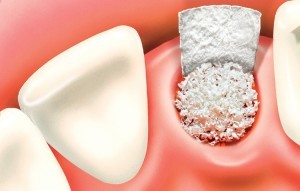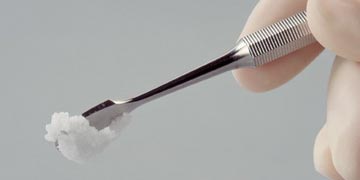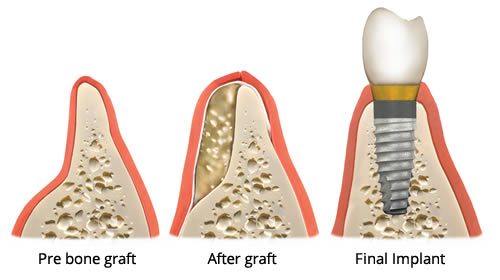In order for the dental implant process to be a success, there must be enough bone in the jawbone to support the implant(s). In cases where the bone under the gum is not wide, tall or dense enough, a bone graft is performed to create a strong foundation of bone for the implant to anchor into. When considering implant surgery, it is important to understand what a bone graft involves, how it is performed and how much it costs.
In This Guide
- Average Cost and Factors
- Sources of Bone Graft Material
- Procedure by Bone Source
- Recovery and Post-Procedure Care
- What to Read Next

Small grafts can be performed by a dentist during implant surgery, while extensive procedures are usually performed by a specialist such as an oral surgeon, prosthodontist or periodontist several months before.
Bone loss can be caused by trauma, an abscess/infection and periodontal disease. In addition, the density of bone beneath missing teeth deteriorates over time. Patients who have been missing teeth for months or years often require bone grafts before they can get implants.
Average Bone Graft Cost
| Single Bone Graft Cost | ||
|---|---|---|
| Simple | Complex | |
| Cadaver, Cow or Synthetic Bone | $250 | $1100 |
| Patient’s Own Bone | $2000 | $3000 |
If a cadaver, cow or synthetic bone is used, the average price of a basic augmentation is around $250-$1100 for a single implant area. Using the patient’s own bone is more expensive and costs $2000-$3000 because it includes two surgical sites as well as hospitalization and anesthesia.
The cost of a bone graft depends upon a number of factors, including the size and shape of the area being worked on, the source material used and where on the bone is harvested from.
Patients may also have to pay additional fees for X-rays ($50-$200), CT scans ($300-$900) or consulting other specialists. For patients who cannot afford the price tag of bone grafts and implants or would rather not wait for the graft to heal, dentures and bridges are the best alternatives to consider.
Dental insurance does not typically cover dental implants, but it may cover part of the cost of a graft if it is deemed to be necessary for the patient’s well-being. For example, if a patient is unable to eat properly due to the bone loss and the problem cannot be resolved by other solutions such as dentures, the procedure should be covered by their health insurance.
Cost of Bone Graft in Other Countries
| Country | Cost |
|---|---|
| Brazil | $1,521 |
| Costa Rica | $283 |
| Croatia | $267 |
| Germany | $1,177 |
| Hungary | $345 |
| India | $2,400 |
| Malaysia | $333 |
| Mexico | $382 |
| Poland | $247 |
| Spain | $958 |
| Thailand | $463 |
| United Arab Emirates | $1,556 |
| United Kingdom | $323 |
4 Sources of Bone Graft Material
The following are the 4 main sources of material used for bone augmentation, listed in order from most effective to least.

Your Own Bone
This source is the safest and most effective because it integrates very well and there is no risk of infectious disease, contamination or tissue rejection. The bone is typically harvested from the chin or jaw, but a shin or hip can also be used. Disadvantages of this source are that it requires two surgical sites, is more expensive and if the bone is taken from the hip or shin, requires general anesthesia and hospitalization.
Human Cadaver Bone
Freeze-dried and sterile, cadaver bone obtained from a reputable tissue bank is more affordable and generally quite safe, although it does carry some risk. Using human bone carries a similar level of risk of transmitting infectious disease to receiving blood from the blood bank.
Animal Bone
Cow bone has been commonly used for many years. It is sterilized and processed to minimize infection, but like human cadaver bone, there is the possibility of contamination. This graft material is naturally absorbed by the body and replaced with real bone over time.
Mineral Bone Substitute (Synthetic)
Although less-effective than the other options, these sterile bone-like materials are second only to a patient’s own bone in terms of safety. This material is also absorbed and replaced over time.
The Procedure
In order to determine if a bone graft is necessary, the extent of grafting required and what source material should be used, panoramic or full-mouth X-rays and/or a CT scan must be taken and analyzed. If the patient’s own bone is to be used, the location it will be harvested from will also be scanned and analyzed.

Chin
First, the oral surgeon administers local anesthesia to both the recipient and donor bone sites. An incision is made in the gum at the recipient site, followed by an incision below the lower front teeth, exposing the chin bone. A block of bone and marrow is removed from the chin.
The surgeon will then cover the area with a layer of tissue or bone substitute to keep the gums from growing into the hole while it heals. After closing the incision at the donor site, the block of donor bone will be placed at the recipient site and anchored in place with small titanium screws which are removed after the recovery period during the implant procedure.
A mixture of marrow and other material is placed around the edges of the block to stimulate bonding. The surgeon then lays down a tissue membrane over the graft before closing the incision.
Shin or Hip
If donor bone is taken from the shin, the surgeon may harvest the bone in the office while administering IV sedation, but if taken from the hip, hospitalization and general anesthesia is necessary. A patient may spend one or two days in the hospital to undergo the procedure. After harvesting the donor bone, it will be placed at the recipient site in the same way described above.
It can take 4-9 months for the augmentation to heal and integrate with the surrounding bone before implants can be placed.
Recovery and Post-Procedure Care
 After the surgery, a patient will be given pain medication, antibiotics and an antibacterial mouthwash. They are advised to avoid certain foods and putting stress on the graft until it heals completely.
After the surgery, a patient will be given pain medication, antibiotics and an antibacterial mouthwash. They are advised to avoid certain foods and putting stress on the graft until it heals completely.
Depending on the size of the graft and the materials used, it can take 4-9 months before the jaw is strong enough to receive implants. During that time, patients are advised to maintain proper oral care (routine brushing and flossing) and a healthy diet to ensure its success.
What to Read Next
- How Much Does a Sinus Lift Cost?
- How to Much Do Dental Implants Cost?
- Dental Implant Problems – What Can Go Wrong
Over to You
Have you had a bone graft done? Or, have you been told you might need one done before you get an implant? Share your experience in the comments!
To prepare for an implant to replace a molar I received a bone craft which cost $800. A few months later when the implant was put in, the Dentist determined that a little more bone should be added. He charged me again $800. Is this reasonable? It seems to me that if the dentist had added enough bone in the first place I wouldn’t have needed more bone on the second visit.
my dental implant for one tooth is completed today by attaching the crown implant. The whole process took 8 months, from bone grafting to the drilling to crown moulding and the tooth implant. It was a less painful process compared to bridging or crowning the tooth I would say. I would recommend a dental implant although very costly over wearing dentures. I was charged 5k dollars + the cost of the bone grafting procedure. If you need a dental surgeon, I highly recommend my dentist. I am thinking of getting my denture (partial) replaced if I could afford it. The estimated cost for the 4 dental implants is from 25k (includes bone grafting) and will be done in 8-9 months. The price is subject to change by next year. The cost of bone grafting alone for 4 teeth is 8k. Is that a reasonable price or average price. I would not have second thoughts of getting my dental implant done by my dentist.
I fractured a front incisor tooth. I had a temp bridge placed and then will have new one -$3300. Inbetween I am to see periodontist who will extract remains of broken tooth and do a bone graft adding my blood.. his cost is $1475. I am a bit overwhelmed but decided not to go implant route since this would end up close to $8000 and take months…..
I lost after 30 yrs 3 implants [left, upper, the last 3]. The implant dentist got a CT of my upper jaw
[mandibula] and said that I need a cadaver bone implant. I called an maxilo-facial surgeon across the dental school on Charleston and asked for estimate. She said: $5500.
Now, I am going to call all the dental surgeons who do grafting and asking for prices. For sure, after the lawyers the dentist are the biggest rip off in this country.
There are many factors into your grafting Karl, there is not a one size fits all approach, the dental school is going to be your less expensive alternative, the doctors probably need to split the ridge and do block grafts or extensive amounts of bone grafting material. Patients have to understand the doctors cost of obtaining materials for patients treatment is very high, and the skill that is applied to this procedure. If everyone could do it then there would be no need for Dentist.
I had two bone grafts in Mexico. He explained the procedure to me because I didn’t know what it was.
He also told me that he would take some of my plasma and mix it with the bone dust as a special precaution.
Apparently they put some of your blood in a machine (centrifical force type) and then use your plasma for extra precaution.
Anyone heard of this or had it done?
I am scheduled for an upper jaw tooth extraction, then a bone graft using my blood along with a filler this month in Palomas. Could you tell me where you went in Mexico and also how did your grafts turn out. For the extraction and graft, I will be paying $500. How does that compare with your expenses a year ago?–Thanks a lot
Bill, I can tell you that’s a great price. Mine is 4500. I have 3 upper teeth from a bridge that I had removed This has been an ordeal. They found a cyst in my sinus so I had to have it removed. Then I waited for 6 weeks for removal of sinus cyst to heal so I could have the graft. They did an X-ray and I now have a sinus infection so I have to take antibiotics for 2 weeks, be rechecked for any infection so I can have my graft Grrrrr What a nightmare. Dr says if you have any infection bone graft will not take. So just be aware if you have any sinus problems. Hope it goes well for you !! I am in Tennessee